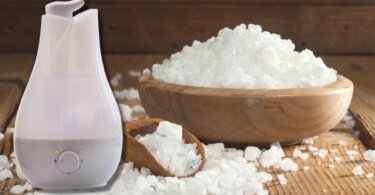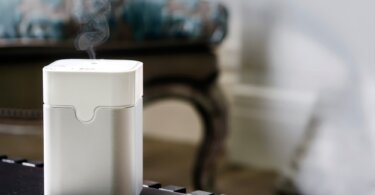You spend so much time choosing the best HVAC or room heating option for your comfort. But have you ever thought about maintaining the level of humidity in your room? Controlling the humidity level is as essential as maintaining the temperature in your room.
You can increase the humidity levels in your home by using a humidifier. But once you buy a humidifier, you might wonder: what should I set my humidifier to?
The ideal relative humidity in your room should be within the 30 to 50 percent range. Let’s talk more about humidity, how it is measured, and what level you should set your humidifier to.

What Should My Humidifier Be Set At?
The ideal range of humidity in your room should be between 30 to 50 percent. If the humidity level goes below or above this range, then you may start feeling uncomfortable. You can measure the humidity levels in your home by using a hygrometer.
What Should My Humidifier Be Set At With Changing Weather Conditions?
The Environmental Protection Agency (EPA) recommends that the humidity level indoors be within 30 to 50 percent at all times, as noted above. But it is hard to maintain this ideal humidity level when the ambient air temperature changes.
For example, if you are using a forced-air heating system, it can decrease the humidity level in your room by replacing the air inside your room with dry ambient air.
If the ambient air temperature is below freezing, you will observe condensation on your doors and windows, which can promote the growth of mold and bacteria.
So, you need to achieve an ideal humidity level that will neither harm you nor the things in your house. As a rule of thumb, the lower the temperature of outside air, the lower should be the humidity level in your home.
Understanding “Relative” Humidity and What the Percentages Mean
The relative humidity is the ratio between the amount of moisture the air is holding and the maximum amount of moisture that the air can hold. It is expressed in percentages.
So if the relative humidity is 50 percent, then it means the amount of moisture in the air is only one-half the maximum amount of moisture that the air can hold.
Similarly, if the relative humidity is 25 percent, then the amount of moisture in the air is one-fourth the maximum amount of moisture that the air can have in total.
If the relative humidity is 100 percent, then the air is completely saturated and cannot hold any more water vapor. If you reduce the temperature further, then the moisture in the air will start condensing. The temperature at which air cannot hold more water vapor is called dewpoint temperature.
You will have realized by now that relative humidity is a function of temperature. Warmer air has more capacity to hold water vapor, whereas cooler air has less ability to hold water vapor. So your ideal humidifier settings should vary by temperature.
So, How Should I Set My Indoor Humidity?
While the usual recommendation is to set the relative humidity between 30 to 60 percent in any season to feel comfortable, you will want to keep a check on the weather too.
When the temperature drops drastically in winter, you should change your humidifier settings. If you maintain the relative humidity of 50 percent in the winter months, you will find condensation on your doors and windows, which can increase mold growth.
You should keep track of the outside temperature. For instance, if the outside air temperature is between 0 to 10 degrees Fahrenheit, then the relative humidity should be above the 30 percent humidity mark to keep condensation from happening.
The below table explains the right humidity settings as per the ambient temperature.
| Ambient Temperature | Right Humidity Levels |
| 20 to 40F | 40% |
| 10 to 20F | 30% |
| 0 to 10F | 30% |
| -10 to 0F | 25% |
| -20 to -10F | 20% |
| Below -20F | 15% |
What Are the Effects of Wrong Humidity Levels?
High Humidity
If the humidity level rises very high in your room, then vapor in the air can start to condense. As a result, you will find water droplets on your windows, door, and floors. Your floor can become slippery because of condensation, which may make someone slip on the floor.
High humidity can affect baked foods like bread or cake. It will make the baked foods extra soft and mushy, which you may not like to eat. It can promote the growth of molds and bacteria, which can adversely affect your health.
If there are water-sensitive things in your home, those can be damaged by the high humidity as well.
Low Humidity
If the humidity is low, it can affect you and your entire house. It can cause cracks in your walls and may cause several problems to you as well, such as:
- Continuously inhaling dry air can make it difficult to breathe.
- You might develop respiratory problems after inhaling dry air consistently for a long time.
- Your skin can become dry, and you might develop skin problems like eczema.
- You are more likely to develop allergies, sore throat, and your skin starts itching on your eyes and nose.
- You might feel colder when the air is dry.
Related article: Best Humidifiers for Hard Water
Frequently Asked Questions
1. Should the humidifier be placed high or low?
You should place the humidifier high up on the floor. The work of a humidifier is to add mist into the air, and mist falls quickly as it has more mass than air.
If you put the humidifier on the floor, then it cannot effectively mix mist into the air.
Also read: What’s The Best Place to Put a Humidifier?
2. Is 60 percent humidity too high?
The ideal range for maintaining relative humidity should be 30 to 60 percent. If the relative humidity is above 60 percent, it’s too high. And you will find water droplets or condensation on doors and windows, promoting the growth of mold and bacteria.
3. Is 35 percent humidity high?
No, 35 percent relative humidity is not considered a high humidity level. It is reasonable to maintain 35 percent relative humidity in your home. But please check the temperature of the outside air and change the setting of the humidifier accordingly.
Related articles:
- How to Use a Humidifier Without a Filter and Keep It Clean?
- What Happens If a Humidifier Runs Without Water for a Long Time?
Wrapping Up
You should maintain the relative humidity in your home so that you feel comfortable. You can refer to this article when there is a change in weather conditions so that you can better understand how to adjust your humidifier setting accordingly.
Thank you for reading this article, and I hope I have covered everything related to the importance of relative humidity indoors.
Related articles:
What Is The Best Water For a Humidifier?
How Much Electricity Does a Dehumidifier Use?
How Long Does a Humidifier Take To Work?





Leave a Comment